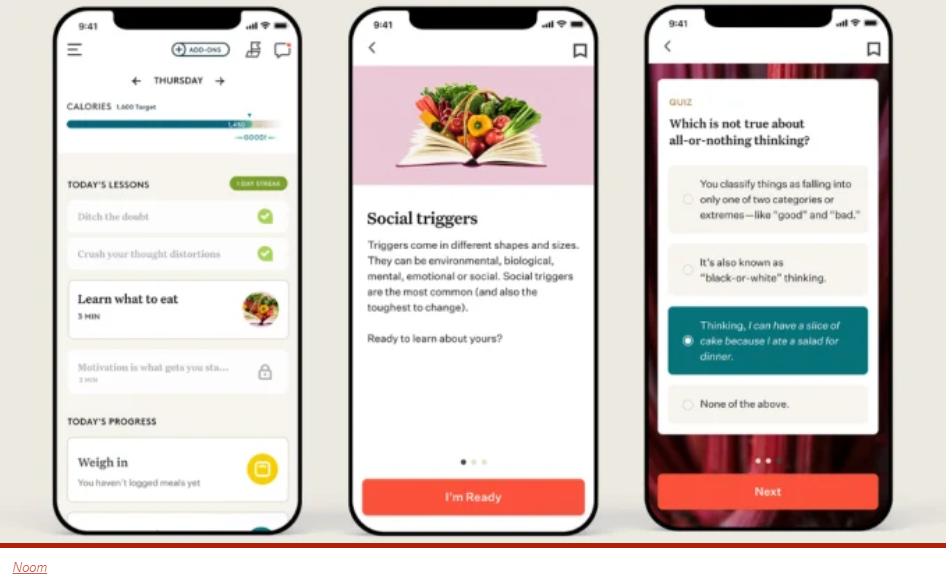You probably cannot be anywhere online without seeing ads for “Noom.” People do report losing weight and cite the power of the “psychology” behind it that differentiates the app from more barebones versions of food trackers. So I tried it for 30 days to – and here is my full review. And I cover other options, in case you decide this may not be the app for you.
Wait, do I need a food tracking app? What if I am not even trying to lose weight?
My recommendation is YES – and think about it. Do you need a budget when you are providing or receiving services? Do you need one to be able to pay your bills? If you just spend money or rack up hours without a budget, you could go way beyond the scope and well, that’s bad. Just like if you (or someone on your payroll) swipe your credit card willy nilly and don’t check the balance, well, you know how you can get that sticker shock with a huge bill.
The same can happen if you have no idea how much you are taking in with calories roughly. You could be way, way off on that number and that number DOES matter. It’s simply a law of thermogenics. You burn a certain number of calories a day, and if you eat way more than that number, you will gain weight. If you need more convincing, read my article on the importance of food tracking:
Even if you are at a weight / body shape you are happy with, food is necessary for so many brain and body functions. It may surprise you to learn through food tracking you are not eating ENOUGH, especially if you are on back to back calls or traveling/in client meetings. If you are eating less than 1200 calories a day, chances are you feel sluggish, maybe even depressed. You could experience premature hair loss, or even bone loss.
So it IS important for everyone, no matter what your goal.
What is Noom and how is it different from other apps?

Noom's big claim to fame is that it offers a psychology-based approach to help users achieve sustainable lifestyle changes. Central to its methodology is a unique color-coded system categorizing foods into green, yellow, and red, fostering awareness and encouraging mindful eating. Beyond the intuitive interface and food tracking features, Noom offers personalized coaching, goal-setting tools, and a wealth of educational content.
However, this comprehensive approach comes with a cost - and it may not be right for everyone.
What is the cost of Noom?
Noom operates on a subscription model, with prices varying based on the plan selected. While the investment is undoubtedly a consideration, many users find the long-term benefits and transformative results well worth the financial commitment. If you want the numbers from Noom, you can check out their own info page:

What is the color-coding system in Noom designed to do?
Noom's food classification system
Noom's orange, yellow, and red color-coding system is a key component of its approach to categorizing foods based on their caloric density and nutritional value. This system is part of Noom's effort to simplify and educate users about making healthier food choices. Here's a breakdown of the color system:
Green Foods (Orange in the Noom App): These are the least calorie-dense and most nutrient-dense foods. They are typically fruits and vegetables, which are rich in essential vitamins, minerals, and fiber.
Yellow Foods: Yellow foods are moderately calorie-dense and may include items like lean proteins, whole grains, and certain dairy products.
Red Foods: Red foods are the most calorie-dense and may include items like sweets, processed snacks, and high-fat foods.
Noom does not categorize any of these foods as "good" or "bad," but does encourage a certain percentage of total calories should be from each of these types of foods.
What are the pros and cons of Noom?
Pros: Good for the stress eater
Noom stands out for its unique approach that delves into the psychology of eating. The app goes beyond simple calorie counting, incorporating behavior change techniques and cognitive-behavioral strategies to promote long-term lifestyle shifts. Noom's color-coded food classification system simplifies nutritional choices, making it easy for users to identify healthy and calorie-dense options.
If you are a person who really benefits from identifying triggers, like emotional eating, eating differently in social settings, the app helps you categorize what "type" of eater you are and what may bring on cravings. It identifies strategies you can use to deal with these cravings and is interactive in that respect.
Cons: Not for the no-nonsense multitasker
While Noom's psychological approach is innovative, some users may find the coaching and feedback system impersonal, as it relies heavily on automated messages. Additionally, the subscription cost may be a limiting factor for budget-conscious individuals.
The other MAJOR downside - the app requires you to weigh yourself every day, whereas MFP only asks you to so once a week. If you are a person who has sensitivity around stepping on a scale. There are days when I certainly know my number will go up by 3-4 pounds - if I ate sushi the night before, or may be retaining water for whatever reason. Many dietitians actually recommend for this reason of constant fluctuation that you should not weigh yourself every single day. That being said, knowing you are going to get on a scale the next day can certainly help you clean up your eating the day before, so it all depends on how you approach it. I do plan on writing a separate post about the pros and cons of weighing yourself!
Why I prefer MyFitnessPal
Note: This is my personal, unaffiliated opinion.
If you don't want a lot of homework and a bunch of psychobabble, MyFitnesssPal is better for you. Here are some key cnsideration:
- MFP may suit "advanced" fitness goals, like hitting certain macros and achieving specific body comp (if you don't know what this means, MFP may not be for you).
- Most of the advice in the Noom app was to me recycled material from years of reading fitness magazines, but it could be new to someone that has never really thought about putting guardrails around their diet.
- If you are super busy and don't want to spend a bunch of time answering quizzes and learning modules MyFitnessPal is a classic calorie counter that gives you more food database options and a detailed snapshot of nutrient intake, including macros (protein, carbs and fat) and sugar, sodium, and other minerals. Of course, you can use MFP to straight up count calories and hit or stay within a targeted range.
If you want to read a primer on macros and IIFYM, check out my article here:
Other options
If budget is not as much of an issue, you can have the best of both worlds. There is a way to use both MFP to track macros, and Noom for the psychology benefits
- Make sure that both apps are connected to the “Health” app
- Enter nutritional information in MyFitnessPal
- The calories will transfer to Noom
There are also other app options, like Lose it!, which are summarized in this article that also compares prices.
The Weight Watchers program and app is also a direct competitor to Noom. Since I have not tried WW, I will leave you with Forbes' comparison if you want to read more:
https://www.forbes.com/health/nutrition/diet/noom-vs-weight-watchers/
I would suggest signing up for a free trial for apps that seem appealing to you, and then see which one you actually end up sticking with after the two weeks. It takes about two weeks to make a habit last, so if you can stick to one of them for that time period, then that's your app.
More resources.
How to make food tracking a habit:
Kazemi, Lili, “The DAO of Metrics,” DAOFitLife, January 18, 2021, https://dao.tiny.us/metrics.






